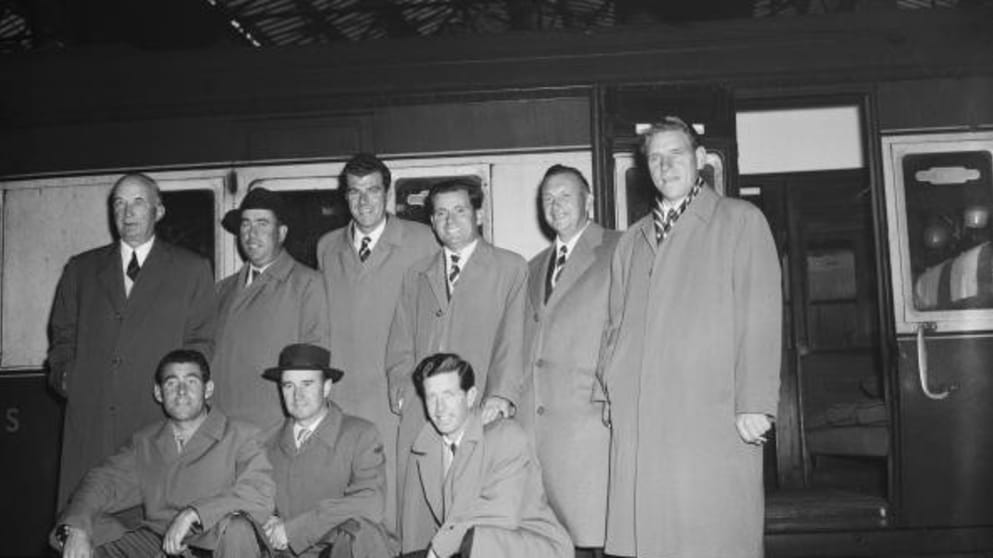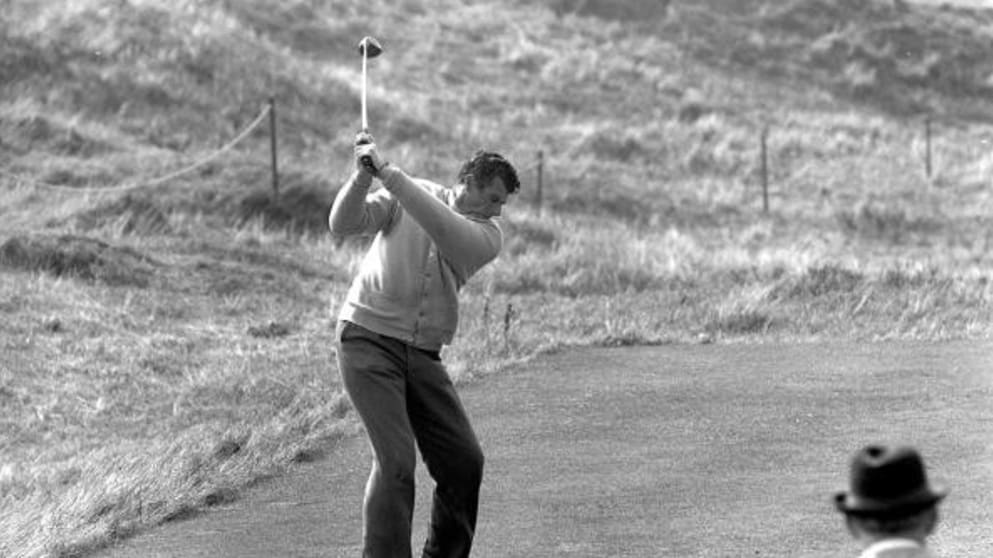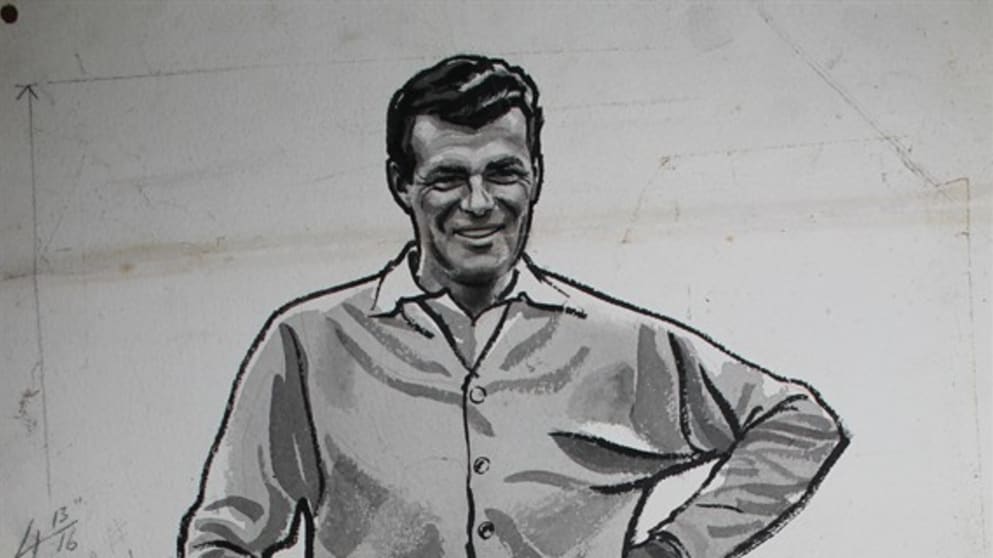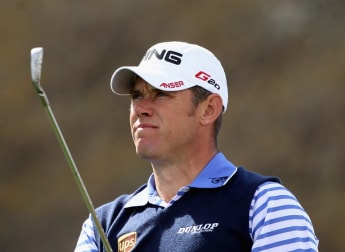To mark the 40th anniversary of the first European Tour event, europeantour.com sat down with its founding father, John Jacobs OBE. In this, the second in a series of features, we look into the golfing heritage and playing career, lineage and experience that shaped the man who would go on to change the face of European golf forever.

There is a natural instinct intrinsic in sports storytelling to loiter precariously on the verge of hyperbole. When John Jacobs, so often the master of understatement, says he was born into the game of golf it is a statement of no such exaggeration.
From the very beginning Jacobs was immersed in golf through the cloth he was cut from; his family possessed unmistakable lineage in the sport, threads reaching down through the history of the game, and his upbringing would prove an environment pivotal in the moulding of a man who would go on to achieve unprecedented success in its sphere.
Born in 1925 in Lindrick, Yorkshire, Jacobs’ father Robert had died when he was just nine after never fully recovering from the effects of four long years in the trenches of France and Flanders in the First World War. ‘Bob’ Jacobs had been professional at Lindrick until his death, but before that he had been assistant to ‘old’ Tom King, professional at Royal West Norfolk Club at Brancaster, who had himself been apprenticed to the legendary figure of ‘old’ Tom Morris at St Andrews.
Jacobs was born, then, into a true line of golfing pedigree if ever there was one.
| ||
| John Jacobs, pictured during the 1955 Open Championship at St Andrews (copyright Bob Thomas / Getty Images) | ||
Along with his sister Pam, two years John’s senior, Jacobs was raised on a shoestring by their mother Vivien, who was Stewardess at Lindrick Golf Club, and all these years later he still remains entirely vociferous about the woman’s qualities.
He readily describes her as, “The best of the Jacobs family by miles” and “an absolute genius.” Such was her standing she was apparently known exclusively as ‘Mrs Jacobs’ and was renowned throughout Yorkshire for her clubhouse food.
And so, despite the penny-pinching, it was undoubtedly a thoroughly happy upbringing for Jacobs, who also developed a lifelong love of the outdoors in these early years thanks to his cousin Jack, professional at Lindrick following his father’s death, teaching young John the art of fly-fishing and hunting, passions he retains to this day.
Recently 87, Jacobs has embraced an imposing presence throughout his life, standing well over six feet tall, and although back problems have curtailed his physical activity somewhat in recent times he still fishes every Monday in season and reveals: “One of the best presents I ever got was a double-barrelled .410 when I was 12 or 13.”
Jacobs’ forte was never academics in school, where he claims to have been “bloody pathetic”, but he did, however, excel in sports and woodwork and it was as a 13 year old schoolboy that Jacobs experienced his most lucid of golfing epiphanies, as he recalls clearly.
“I had lost my dad four years earlier but my mother took me to The Open Championship at Royal St Georges in 1938,” he says, the delight of the memory flickering in his dark eyes. “I watched Henry Cotton play like God through the eye of one of the fiercest gales I’ve ever seen. He didn’t win, but it certainly left an impression and from then on I was hooked.”
Jacobs graduated through Royal Air Force training during the latter stages of the Second World War and in spite of not going into active service he was earmarked as officer material, an early indicator of the skills in leadership that would come to the fore so spectacularly during his establishment of The European Tour in the early 1970s.
During his spell years in the RAF Jacobs met his future wife, Rita Wragg, and decided instantaneously that “she was the one for me” and after he was demobilised from the RAF in 1947 he secured his first paid job in golf as an assistant to Hallamshire professional Willie Wallis.
Wallis was a “wonderful club maker,” he says, and it was at Hallamshire where Jacobs began to teach and put his schoolboy woodwork skills to use slaving over a vice shaping clubfaces during the long and chilly winter months. “I loved it though,” he says.
After marrying Rita in 1949, Jacobs made the bold decision as a 24 year old to move with his new wife to Cairo, Egypt, to take on the professional’s job at Gezira Sporting Club. It was a high-pressure environment in which his teaching flourished but he soon missed the thrill of the few competitive events he had played in England. (He did play some exhibition matches in Cairo, notably one in 1951 with five-times Open Champion Peter Thomson during his first excursion out of Australia.)
Nevertheless, Jacobs still attests the decision to up sticks was a sound one, and says: “It was the best decision I ever made in my golf career. When I came back to Britain after shouldering all that responsibility, almost any normal situation seemed easy to cope with.”
Indeed, it was in dramatic circumstances that Jacobs left Cairo to return to British shores, amidst the Egyptian Revolution of 1952, but the experience proved an important juncture in Jacobs’ life.
“We were very lucky to get out of Egypt when the whole place blew up,” he reflects. “They burnt down Shepherds Hotel, we had tanks in Gezira Sporting Club, it was mayhem. But get out we did and afterwards I said to Rita, ‘I’m not going to get a job darling, I’m going to play’, and so I played.”
Jacobs used the rest of 1952 to reacclimatise himself back into tournament golf in Britain, playing much of the-then April to September season and with it putting together a handful of top 12 finishes. To be competing again after his time in Egypt provided him with a welcome boost, and in December of that year he took on the role of professional at Sandy Lodge, just to the north west of London – a job he would remain in throughout his 11 or so years of successful tournament play.
On top of a tied 14th place finish at the 1953 Open Championship at Carnoustie, as Ben Hogan completed his famous victory, it was also in the same year that Jacobs began to establish himself as somewhat of a match play specialist.
He came second in the Goodwin Foursomes at Lindrick with partner Trevor Allen – beaten in a 36 hole final by Bernard Hunt and Jack Hargreaves – before being knocked out by eventual winner Max Faulkner in the semi-finals of the PGA Match Play Championship on the last green later that year.
Jacobs could consider himself somewhat unlucky to not have made the team for The 1953 Ryder Cup match at Wentworth, especially after having been invited to the 16-man trial two weeks before the event.
“I had played ever so well in the match play events that year but was ultimately disappointed to have been defeated by Max,” he recalls. “I was in the car on the way home when I heard on the radio I had been added to the trials but, despite winning two of the four medal rounds at Wentworth, Henry Cotton decided not to pick me.”
His Ryder Cup chance would come soon enough. The following year there were another two near-misses in the form of a 36-hole play-off defeat to Ugo Grappasonni in the Italian Open at Villa d’Este, having led by five shots going into the final round (“Everybody had left but there were all these Italian caddies around and whenever the ball went into the woods it came out shining!” he quips), and a loss in the final of the Penfold 2000 Guineas match play tournament at Maesdu to the aforementioned Henry Cotton.
“Before the final we decided to split the first prize,” Jacobs reveals. “I lost 4&3 but I wasn’t bothered, I’d got my money. It’s not like I wasn’t trying but, having competed like a flipping bull-cat after a mouse all week, I wasn’t playing as hard as I would’ve done. Winning the title was the important thing to Henry.”
The years 1955 and 1957 were by far the finest in Jacobs’ modest playing career. Of the 14 Open Championships he contested Jacobs had five top 20 finishes, but it was the 1955 tournament at St Andrews that provided what Jacobs describes as his “one chance.” Having trailed eventual winner Peter Thomson by one shot going into the final round, he was playing superbly but the putts – as they sometimes have a tendency to – were refusing to drop.
“Coming off the 12th green, I’d hit ten fours and two threes and I’d had a putt for birdie on every single green and didn’t make one,” he says. “I had been a coward really, I hadn’t been hitting them hard enough.”

The 1955 British Ryder Cup Team at Waterloo Station
It was a case of personal triumph over team success for Jacobs in California, with the British team succumbing to the United States 8 points to 4. With help from fellow Yorkshireman Johnny Fallon in the opening foursomes, Jacobs contributed 50 per cent of his teams points haul and was the only man from his side to emerge from the event with an undefeated record having also defeated the prolific Tennessean and three-time Major Champion Cary Middlecoff in his singles match.
“I simply loved playing in it,” Jacobs enthuses. “In the Foursomes, Dai Rees [the British Captain] had paired John and me together because he knew we had known each other since the ‘30s. But also, he was the oldest member of the team and I was the youngest. We had the most wonderful game.”
The encounter against Jerry Barber and Chic Harbert was, indeed, an extraordinary match during which Barber chipped in an astonishing three times, including on the 36th hole. Only needing a half for the point, though, Fallon poured an eight foot putt straight into the back of the hole. “The result made such a difference to my attitude to the singles the next day,” Jacobs reflects.
And his singles match against Middlecoff, at that time in his absolute pomp, would prove to be no less astounding. Almost 57 years later, Jacobs’ memory of the day is crystalline.
“I was two down after the morning round after I’d shot 69 and he’d hit 67,” he says. “I went out in 32 to square the match before making birdies at the 12th and 13th to go two up, before Cary holed a huge thing of a putt on the 17th to take it down to the final hole.”
With Middlecoff safely in for par, Jacobs was left with a snaking downhill six footer to halve the hole and win the match.
“Everybody around that green knew the game was going to be halved now, except me. I just knew I was going to hole it; I distinctly remember thinking, ‘How on earth do I know I’m going to hole this one, when the whole of the rest of my life I’ve known I’m going to miss them?’”
And just as prophesised, in she rolled, straight into the heart of the cup. Although much of Jacobs’ playing career could be construed as ‘middle of the road’, this had been a truly breath-taking performance – ten under par over the 36 holes under the greatest of pressure – and one that suggested, on his day, he was a match for the very best.
“Every hole was contested, no hole was given, and I won with the last putt on the last green. I can’t think of many better matches.
“He was a much better player than me but on the day, I won. And he said that wonderful thing to me afterwards: ‘Well played John, I want you to know you beat me on one of my best days’. What a gentleman he was.”
It was a performance that would have far-reaching consequences in Jacobs’ future, as Laddie Lucas, his biographer, testifies: “His place in the side, and especially his maximum points in the contest, contributed significantly to his colleagues’ choice of him, a quarter of a century later, as Captain of the first European team.”
Much like London buses, after coming close on a number of occasions, Jacobs’ two tournament victories came along in the same year, two years later in 1957. In the early segment of that year he had been on a tour of South Africa with his close friend Bernard Hunt, the highlight of which came in the form of a victory on the 35th hole of the South African Match Play Championship over nine-times Major Champion Gary Player, having already seen off Harold Henning, who had won the previous four events in a row, in the semi-final.
Later that year Jacobs would also return triumphant from the Dutch Open at Hilversum, but quite extraordinarily and inexplicably would miss out on a spot in the 1957 Ryder Cup match, even more gallingly to be played at the course he had grown up playing, Lindrick.

Jacobs in action at Royal Birkdale in 1963
Having spent some time in America playing invitationals and events such as the Bob Hope Classic at Palm Springs in 1955, I ask Jacobs whether he ever had the opportunity to play any of the American Majors, eliciting a remarkable response.
“Well in those days you couldn’t qualify for the US Open, and you had to be a member of their PGA to play in the US PGA,” he replies. “I was twice invited to play in the Masters in 1956 and ‘57 after my performance in The Ryder Cup but my flipping lesson book was full so I just had to thank them for their kind invitation but say no.”
After another second place at the 1961 German Open, two years later at the age of just 38, Jacobs retired from his life as a professional golfer. In a manner typical of the Jacobsian level-headedness he has so often exhibited, he says, simply: “My career up to that point had run its course.” He had come to realise – largely thanks to continued interruption to his tournament schedule by happy punters perpetually filling up his lesson book – that his true calling lay elsewhere.
“My bent was really for teaching the game and I could feel I was much better at that than I was playing,” he remembers with not a trace of regret. “I had total confidence in myself as a teacher. I never had quite the same feeling as a player.”
And while it is certainly true to say that Jacobs perhaps didn’t quite scales the same heights – at least in terms of tournament wins – of his more celebrated contemporaries and close friends such as Alliss, Hunt, O’Connor et al. he was, as Lucas points out, “seldom far behind,” having never placed outside of the top 20 in the Order of Merit during his career.
The majority of Jacobs’ success as a player had had a tendency to materialise during his forays abroad, not surprisingly coinciding with the periods when he actually had time to work on his own game, free from the distractions of what were frequent – yet always willing – impromptu range lessons on home soil.
Bernard Gallacher, in a tribute to Jacobs prefacing Peter Dobereiner’s Golf in a Nutshell with John Jacobs, recalls much of the same: “It was not his swing that caught my eye or the way he addressed the ball, but rather the fact that he never had time to practise himself because so many of his colleagues kept asking for advice. As always, it was freely given.”
The response of Jacobs’ students, even from his earliest ventures into golf coaching, had shown all the portents of another burgeoning career, a career that would eventually make him the one of the most revered teachers in the world.
But it was his upbringing in such a golf-centric environment, and the experience he gained from years as a hardened tournament professional, that shaped the man now known popularly by the synonym “Dr Golf”, the grandmaster of The European Tour, and spelt out Jacobs’ future odyssey of a lifetime in the game.
In the years following his retirement he would become Managing Director of Athlon Sports, with whom he would pioneer floodlight driving ranges in Britain, and after which would come his substantial impact on the formation of The European Tour and later, The Ryder Cup.
You get the sense, though, that for Jacobs – who even in the midst of far-flung tales about the greats of the game retains a wholly down to earth aura – it is the people of golf that define the sport and the friends he made at the very beginning and along the way that mean the most to him, as evidenced by another memorable story involving his dear old pal Peter Alliss.
“I love the game and I love the people in it,” Jacobs says, resting for a moment against the front gate of the converted coach house he shared with his late wife Rita for over 35 years. “I remember at The Open at St Andrews in 1955, there was a big hold up on the fifth green – the big green that doubles up with the 13th – when Peter shouted to me, ‘Coming up’, and bowled a golf ball down to me, overarm, a nice juicy half-volley I might add.
“I happened to have a mallet putter in my hand and stepped up to the pitch of the ball with the intention of only pretending to strike it. Instead of missing it, though, I caught it right out of the middle, a perfect straight drive that whistled past Peter’s head and almost killed some people on the 13th green.
“When I got to the 18th, Brigadier Brickman [then Secretary of the Royal and Ancient] pulled me aside and said sternly, ‘I hear you’ve been playing cricket on the hallowed turf’ to which I responded, ‘I can only apologise sir, it’s the best cricket shot I’ve ever hit in my life’.”
Gazing wistfully into the distance, a thoughtful half-smile cast across his face, Jacobs bears the look of a man revelling in fond memories from his early days, and the story ends in familiar fashion with a sentiment that pays testament to his hugely likeable character, a trait that has served him magnificently throughout a stellar career that began in Lindrick, Yorkshire, almost seven decades ago.
John Jacobs, for the umpteenth time that day, says this time of ‘Bricky’: “We became very great friends in the end, actually…”
Interview by Will Pearson








